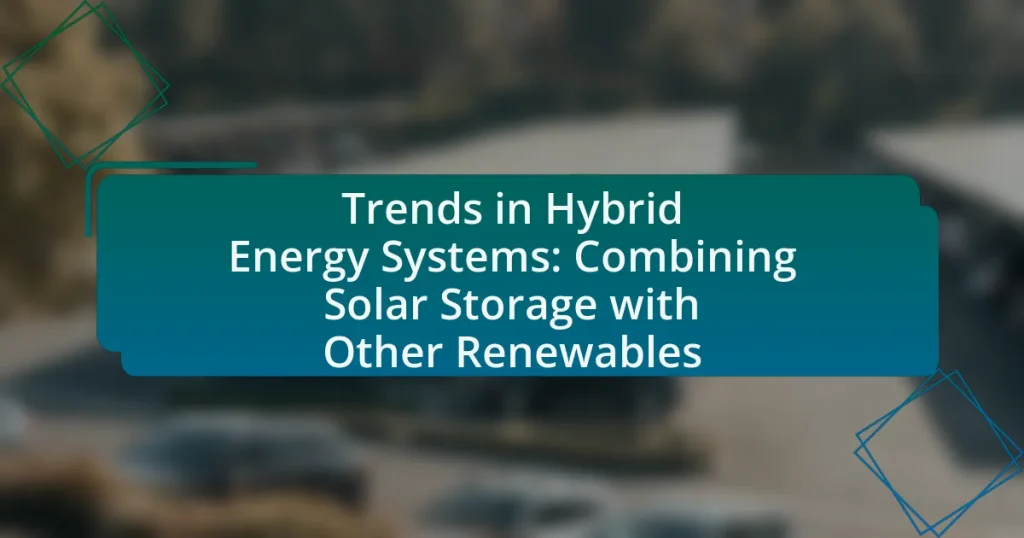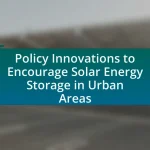Hybrid energy systems are integrated setups that combine various energy sources, such as solar, wind, and fossil fuels, to enhance energy production and reliability. This article explores the significance of hybrid energy systems, focusing on how they integrate renewable sources, particularly solar storage, to optimize efficiency and reduce greenhouse gas emissions. It discusses current trends, technological advancements, and the role of policy changes in promoting these systems, as well as the benefits of combining solar storage with other renewables. Additionally, the article addresses challenges, best practices for implementation, and common pitfalls to avoid in hybrid energy projects, providing a comprehensive overview of the evolving landscape of hybrid energy systems.
What are Hybrid Energy Systems and Their Importance?
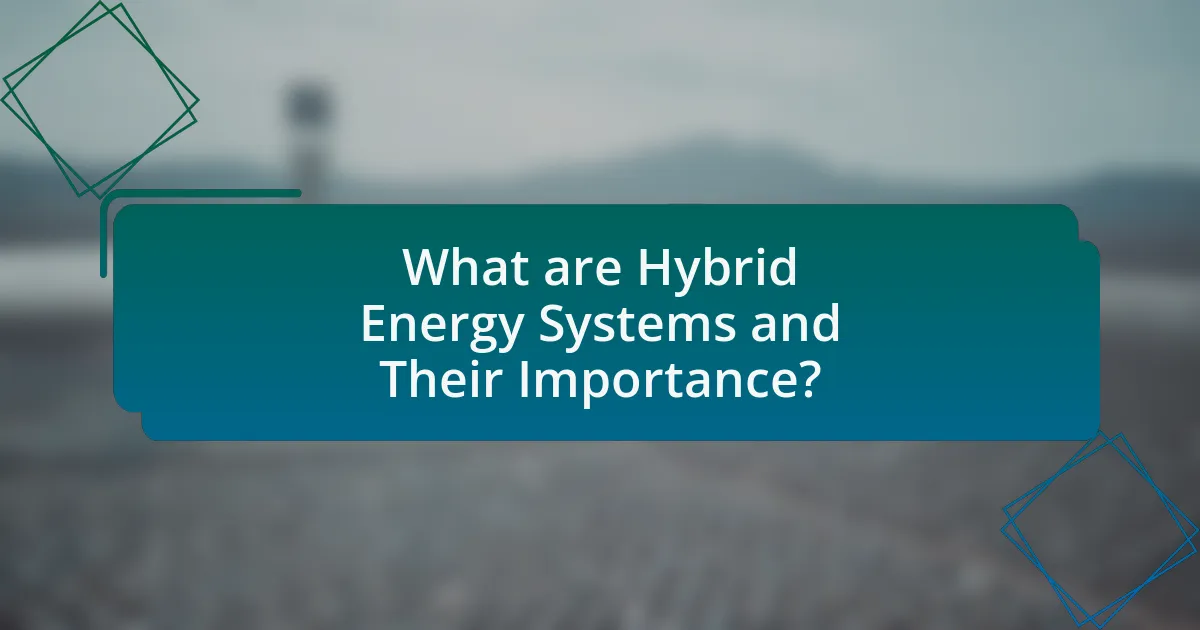

Hybrid energy systems are integrated setups that combine multiple energy sources, such as solar, wind, and fossil fuels, to optimize energy production and reliability. Their importance lies in their ability to enhance energy efficiency, reduce greenhouse gas emissions, and provide a more stable energy supply by leveraging the strengths of different energy sources. For instance, a hybrid system that combines solar panels with battery storage can generate electricity during the day and store excess energy for use at night, thereby ensuring a continuous power supply and minimizing reliance on fossil fuels. This approach not only supports the transition to renewable energy but also addresses energy security and sustainability challenges.
How do Hybrid Energy Systems integrate different renewable sources?
Hybrid Energy Systems integrate different renewable sources by combining technologies such as solar, wind, and biomass to optimize energy production and reliability. These systems utilize advanced control algorithms to manage the output from each source, ensuring a stable and continuous energy supply despite the variability inherent in renewable resources. For instance, solar panels can be paired with wind turbines to balance energy generation; when solar output is low due to cloud cover, wind energy can compensate, thus enhancing overall system efficiency. This integration is supported by energy storage solutions, which store excess energy generated during peak production times for use during periods of low generation, further stabilizing the energy supply.
What role does solar storage play in Hybrid Energy Systems?
Solar storage plays a crucial role in Hybrid Energy Systems by enabling the efficient use of solar energy, particularly during periods of low sunlight or high demand. It allows for the capture and storage of excess solar energy generated during the day, which can then be utilized during nighttime or cloudy conditions, thus enhancing the reliability and stability of the energy supply. According to the International Renewable Energy Agency, integrating solar storage with other renewable sources can increase the overall efficiency of energy systems by up to 30%, demonstrating its significant impact on energy management and sustainability.
How do other renewables complement solar storage in these systems?
Other renewables, such as wind and hydroelectric power, complement solar storage by providing a more consistent energy supply and enhancing grid stability. For instance, wind energy often peaks during different times than solar energy, allowing for a more balanced energy generation profile throughout the day and night. This complementary generation reduces reliance on solar storage alone, as wind can fill in gaps when solar output is low, particularly during cloudy days or at night. Additionally, hydroelectric systems can act as a flexible energy source, quickly ramping up or down to match demand and support solar energy fluctuations. This synergy among renewables leads to improved efficiency and reliability in hybrid energy systems, as evidenced by studies showing that integrating multiple renewable sources can increase overall system performance and reduce energy costs.
What are the current trends in Hybrid Energy Systems?
Current trends in Hybrid Energy Systems include the integration of solar energy with energy storage solutions and other renewable sources such as wind and biomass. This combination enhances energy reliability and efficiency, allowing for a more stable power supply. For instance, the International Renewable Energy Agency reported that hybrid systems can reduce energy costs by up to 30% compared to traditional energy sources. Additionally, advancements in battery technology, such as lithium-ion and flow batteries, are improving the storage capacity and lifespan, making these systems more viable for widespread adoption.
How is technology evolving in the field of Hybrid Energy Systems?
Technology in the field of Hybrid Energy Systems is evolving through advancements in energy storage, integration of diverse renewable sources, and enhanced control systems. Recent developments include the use of advanced battery technologies, such as lithium-sulfur and solid-state batteries, which offer higher energy densities and longer lifespans compared to traditional lithium-ion batteries. Additionally, the integration of artificial intelligence and machine learning algorithms is optimizing energy management and predictive maintenance, improving system efficiency and reliability. According to a report by the International Renewable Energy Agency (IRENA), hybrid systems combining solar, wind, and storage technologies can reduce costs by up to 30% while increasing energy resilience and flexibility.
What are the emerging market demands driving these trends?
Emerging market demands driving trends in hybrid energy systems include the increasing need for sustainable energy solutions, energy security, and cost-effectiveness. As countries strive to meet climate goals, there is a growing demand for renewable energy sources, particularly solar, which is often combined with storage technologies to enhance reliability. According to the International Renewable Energy Agency (IRENA), the global solar energy capacity has increased significantly, with a 22% rise in 2020 alone, reflecting the urgent need for cleaner energy alternatives. Additionally, the rising costs of traditional fossil fuels and the volatility of energy prices have led consumers and businesses to seek more stable and affordable energy solutions, further propelling the adoption of hybrid systems that integrate solar storage with other renewables.
What are the Benefits of Combining Solar Storage with Other Renewables?
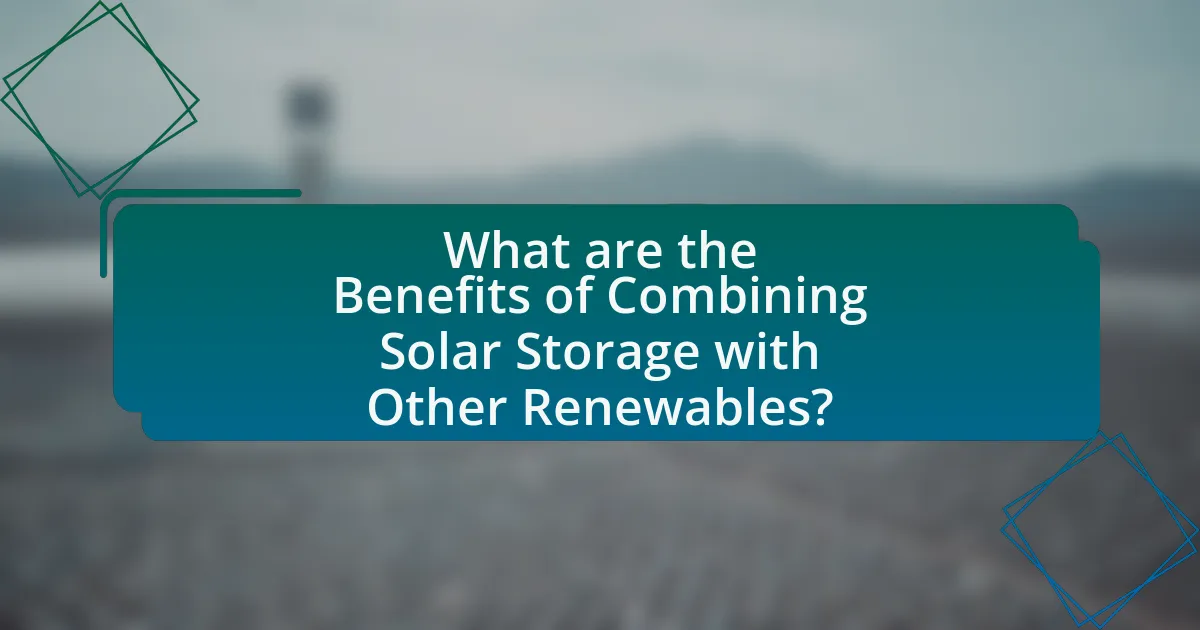

Combining solar storage with other renewables enhances energy reliability and efficiency. This integration allows for the storage of excess solar energy generated during peak sunlight hours, which can then be utilized during periods of low solar generation or high demand. For instance, when paired with wind energy, solar storage can smooth out the intermittent nature of both energy sources, ensuring a more consistent power supply. Additionally, studies indicate that hybrid systems can reduce overall energy costs by optimizing the use of available resources, leading to lower reliance on fossil fuels and decreased greenhouse gas emissions.
How does this combination enhance energy efficiency?
The combination of solar storage with other renewable energy sources enhances energy efficiency by optimizing energy use and reducing waste. This integration allows for the storage of excess solar energy generated during peak sunlight hours, which can then be utilized during periods of low solar generation, such as nighttime or cloudy days. According to the National Renewable Energy Laboratory, hybrid systems can achieve up to 30% greater efficiency compared to standalone systems by balancing supply and demand more effectively. This synergy not only maximizes the use of renewable resources but also minimizes reliance on fossil fuels, leading to a more sustainable energy landscape.
What are the cost implications of using Hybrid Energy Systems?
The cost implications of using Hybrid Energy Systems include initial capital investment, operational costs, and potential savings on energy bills. Hybrid systems, which combine solar energy with other renewable sources like wind or biomass, typically require higher upfront costs due to the integration of multiple technologies and storage solutions. However, these systems can lead to reduced operational costs over time, as they often utilize free renewable resources and can decrease reliance on fossil fuels. For instance, a study by the International Renewable Energy Agency (IRENA) found that hybrid systems can lower energy costs by up to 30% compared to traditional energy sources in certain regions. Additionally, government incentives and decreasing prices for solar panels and batteries can further mitigate initial costs, making hybrid systems more economically viable in the long run.
How does this approach contribute to sustainability goals?
This approach contributes to sustainability goals by enhancing energy efficiency and reducing greenhouse gas emissions. Hybrid energy systems that combine solar storage with other renewable sources, such as wind or hydro, optimize energy production and consumption, leading to a more reliable and resilient energy supply. According to the International Renewable Energy Agency, integrating multiple renewable technologies can increase overall system efficiency by up to 30%, significantly lowering reliance on fossil fuels and minimizing environmental impact.
What challenges do Hybrid Energy Systems face?
Hybrid Energy Systems face several challenges, including integration complexity, cost, and reliability. The integration of multiple energy sources, such as solar and wind, requires sophisticated control systems to manage their variability and ensure a stable power supply. This complexity can lead to increased operational costs and technical difficulties. Additionally, the initial investment for hybrid systems can be high, which may deter adoption despite long-term savings. Reliability is another concern, as the dependence on multiple energy sources can lead to performance issues if one source underperforms or fails. These challenges are supported by studies indicating that effective management and technological advancements are crucial for optimizing hybrid energy systems.
What are the technical barriers to implementation?
The technical barriers to implementation of hybrid energy systems combining solar storage with other renewables include integration complexity, energy management challenges, and high initial costs. Integration complexity arises from the need to synchronize different energy sources and storage technologies, which often require advanced control systems and interoperability standards. Energy management challenges involve optimizing the use of multiple energy sources to ensure reliability and efficiency, necessitating sophisticated algorithms and real-time data analysis. High initial costs are associated with the installation of diverse technologies and infrastructure, which can deter investment despite potential long-term savings. These barriers have been documented in studies such as “Challenges and Opportunities for Hybrid Renewable Energy Systems” by Smith et al., highlighting the need for technological advancements and policy support to overcome these obstacles.
How do regulatory frameworks impact Hybrid Energy Systems?
Regulatory frameworks significantly influence Hybrid Energy Systems by establishing guidelines that dictate the integration and operation of various energy sources. These frameworks can promote or hinder the adoption of hybrid systems through incentives, standards, and compliance requirements. For instance, supportive policies such as feed-in tariffs or tax credits can encourage investments in solar storage and other renewable technologies, leading to increased deployment of hybrid systems. Conversely, stringent regulations or lack of clarity in policies can create barriers, limiting the growth and efficiency of these systems. The International Renewable Energy Agency (IRENA) reports that countries with clear regulatory frameworks see higher rates of renewable energy integration, demonstrating the critical role of regulations in shaping the landscape of Hybrid Energy Systems.
What are the Future Prospects for Hybrid Energy Systems?
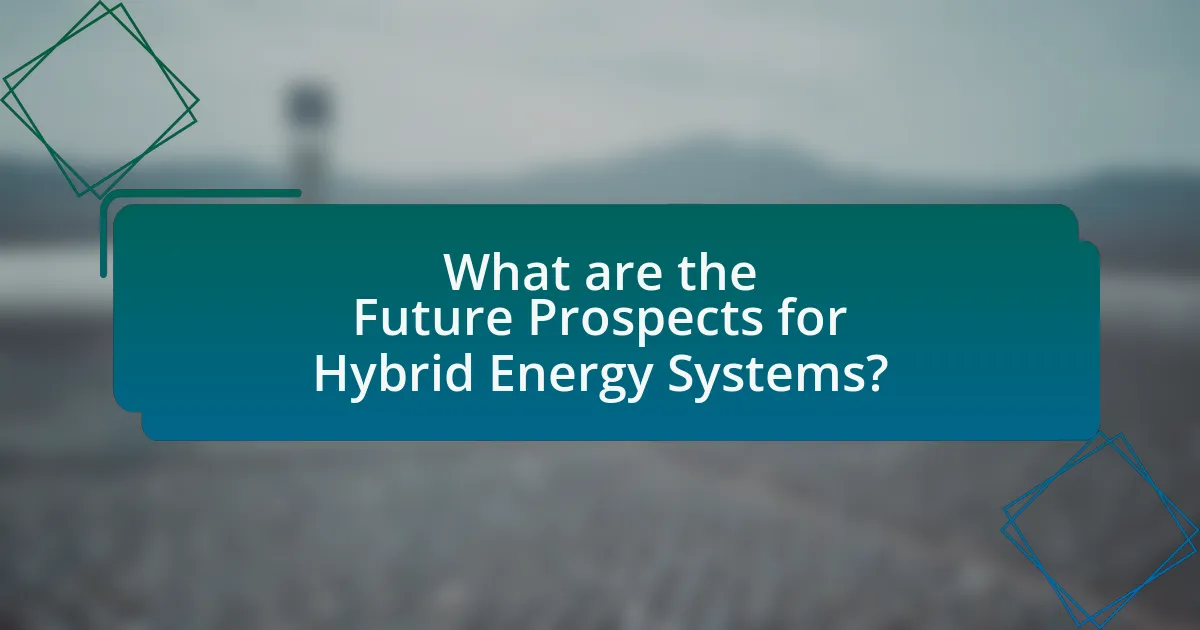

The future prospects for hybrid energy systems are highly promising, driven by advancements in technology and increasing demand for sustainable energy solutions. Hybrid energy systems, which combine multiple energy sources such as solar, wind, and storage technologies, are expected to enhance energy reliability and efficiency. According to a report by the International Renewable Energy Agency (IRENA), the global capacity for hybrid systems is projected to grow significantly, with a compound annual growth rate of over 20% from 2020 to 2030. This growth is supported by declining costs of renewable technologies and storage solutions, making hybrid systems more economically viable. Additionally, government policies and incentives aimed at reducing carbon emissions are further propelling the adoption of hybrid energy systems, positioning them as a key component in the transition to a low-carbon energy future.
How will advancements in technology shape the future of Hybrid Energy Systems?
Advancements in technology will significantly enhance the efficiency and integration of Hybrid Energy Systems by enabling better energy management and storage solutions. Innovations such as advanced battery technologies, like lithium-sulfur and solid-state batteries, will increase energy density and reduce costs, making it more feasible to store energy from solar and other renewable sources. Additionally, improvements in artificial intelligence and machine learning will optimize energy distribution and consumption, allowing for real-time adjustments based on demand and supply fluctuations. For instance, the International Renewable Energy Agency (IRENA) reported that integrating smart grid technologies can lead to a 30% increase in energy efficiency. These technological advancements will ultimately facilitate a more reliable and sustainable energy future by maximizing the potential of hybrid systems.
What role will policy changes play in the adoption of these systems?
Policy changes will significantly influence the adoption of hybrid energy systems by creating regulatory frameworks that incentivize investment and innovation. For instance, governments can implement subsidies, tax credits, or grants that lower the financial barriers for adopting solar storage combined with other renewable sources. Research from the International Renewable Energy Agency indicates that supportive policies can lead to a 30% increase in renewable energy deployment within five years. Additionally, clear regulations can streamline permitting processes, making it easier for developers to bring hybrid systems to market.
What best practices should be followed when implementing Hybrid Energy Systems?
Best practices for implementing Hybrid Energy Systems include conducting a thorough site assessment, selecting appropriate technologies, optimizing system design, ensuring regulatory compliance, and implementing effective monitoring and maintenance strategies. A comprehensive site assessment identifies local resource availability, load profiles, and environmental conditions, which are crucial for system efficiency. Choosing compatible technologies, such as solar panels combined with wind turbines or battery storage, enhances energy reliability and performance. Optimizing system design involves integrating components to maximize energy output and minimize costs, while adhering to local regulations ensures safety and legal compliance. Finally, establishing a robust monitoring and maintenance plan is essential for long-term system performance and reliability, as evidenced by studies showing that regular maintenance can improve energy output by up to 30%.
How can stakeholders ensure optimal performance of these systems?
Stakeholders can ensure optimal performance of hybrid energy systems by implementing regular maintenance, utilizing advanced monitoring technologies, and optimizing system design. Regular maintenance helps identify and rectify issues before they escalate, thereby maintaining system efficiency. Advanced monitoring technologies, such as real-time data analytics, allow stakeholders to track performance metrics and make informed adjustments. Additionally, optimizing system design by integrating compatible renewable sources, like solar and wind, enhances energy output and reliability. Research indicates that systems designed with a focus on compatibility and efficiency can achieve up to 30% higher performance compared to less optimized configurations.
What are the common pitfalls to avoid in Hybrid Energy System projects?
Common pitfalls to avoid in Hybrid Energy System projects include inadequate system design, lack of integration between components, and insufficient financial analysis. Inadequate system design can lead to inefficiencies and underperformance, as seen in projects where mismatched capacities between solar and storage components resulted in energy losses. Lack of integration can cause operational issues, as demonstrated in cases where communication failures between renewable sources and storage systems hindered optimal performance. Insufficient financial analysis may result in budget overruns and project delays, as evidenced by studies showing that projects without thorough financial planning often exceed initial cost estimates by over 20%.
